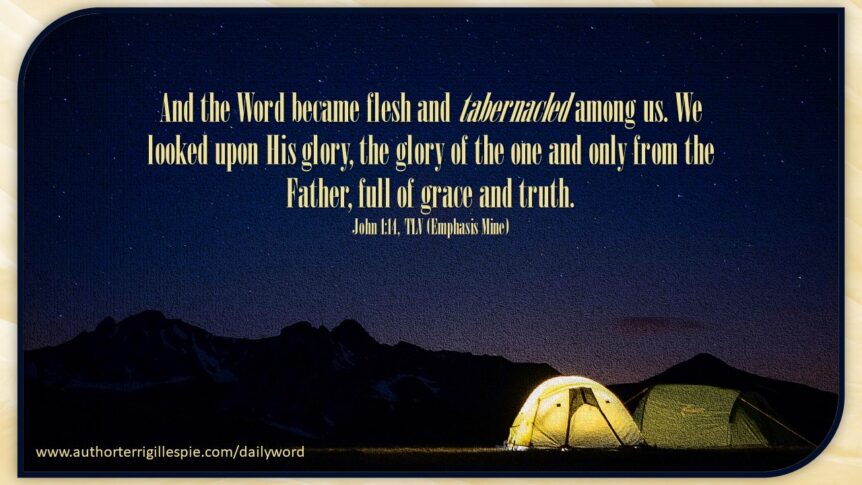And the Word became flesh and tabernacled among us. We looked upon His glory, the glory of the one and only from the Father, full of grace and truth. John 1:14, TLV (Emphasis Mine)

What is in a Word? Plenty! Did you see that? This translation (the Tree of Life Version) uses tabernacled, not dwelt or made His dwelling. Why? Because this word carries more meaning, and its context goes back to the beginning of the Bible.
Then the cloud covered the Tent of Meeting, and the glory of ADONAI [the LORD] filled the Tabernacle. (Exodus 40:34, TLV Emphasis Mine)
What is a tabernacle? Actually, there were two types of tabernacles. The ordinary tabernacles built by the Children in the Israel as temporary dwellings until they reached the Promised Land—Israel—and built permanent dwellings. Tabernacles could be packed up and moved quickly when the LORD guided them to new locations during their forty-year journey.
Then there was the Holy Mishkan (dwelling), the Tabernacle built to house the altars, Ark of the Covenant, etc. Here is where the sacrifices were performed by the tribe of Levi—the Levites. Within the tribe of Levi was Aaron—Moses’ brother—and his descendants. Aaron and his descendants were responsible for the most holy of the sacrifices carried out on Yom Kippur—the Day of Atonement. Yet, the dwelling was portable and was moved by the Levites when ADONAI said to move. It was meant to be temporary.
It was actually King David who brought up the idea of building a Temple for GOD. And, well, GOD didn’t really appreciate that (2 Samuel 7). The Mishkan was meant to be temporary and mobile. Why? Once the Jewish people were established in Israel and living in permanent homes, it would stand to reason that GOD needed one, too. GOD? Needed a permanent home?
In all My journeying among all the children of Israel, did I ever speak a word to any of the tribes of Israel, whom I commanded to shepherd My people Israel, saying, ‘Why have you not built Me a house of cedar?’ (2 Samuel 7:7, TLV, Emphasis Mine)
Is a picture beginning to form?
The Holy Mishkan was meant to be temporary—filled with ADONAI’s glory, where the sacrifices for sins were accomplished. Yeshua tabernacled among us for a season, to accomplish His purposes, most importantly the atonement for our sins.
It was to a fallen Samaritan woman at a well that Jesus revealed the great revelation of The Tabernacle:
Yeshua tells her, “Woman, believe Me, an hour is coming when you will worship the Father neither on this mountain nor in Jerusalem. You worship what you do not know; we worship what we know, for salvation is from the Jews. But an hour is coming—it is here now—when the true worshipers will worship the Father in spirit and truth, for the Father is seeking such people as His worshipers. God is Spirit, and those who worship Him must worship in spirit and truth.” (John 4:21-24, TLV
Where am I going with this? What does this have to do with a babe in a manger? Prophecy said the Anointed One—the Messiah—would be born in Bethlehem—humble and the least of the clans (Micah 5:1). Not a palace, or even an inn, but a stable. A temporary dwelling for them.

Sigh. There is so much more. Perhaps if you all are interested, maybe I’ll do a series. Until that possibility, using that one word carries the whole of Scripture. It is why many scholars believe that Yeshua was born in the Fall, during Sukkot—the Feast of Tabernacles.
Regardless of when He arrived, He came, and we praise our Father that He did!
Happy Hanukkah and Merry Christmas and Shabbat Shalom!



